Minolta S-100, Vectis User Manual
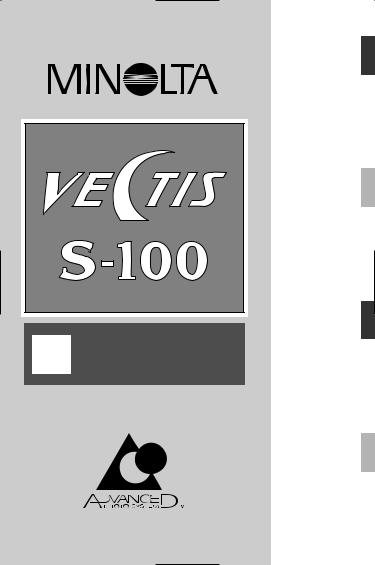
BASIC
OPERATION
ADVANCED
OPERATION
ADDITIONAL
FEATURES
INSTRUCTION E MANUAL
APPENDIX
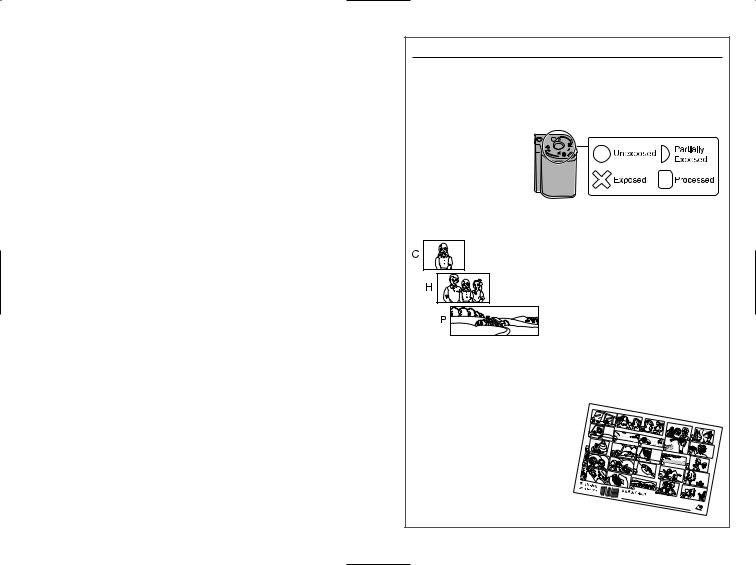
Thank you for purchasing the Minolta Vectis S-100. The Vectis S-100 is an ultra compact IX240 type system camera with variable print-aspect-ratio and magnetic storage of date and exposure information. The Vectis S-100 also incorporates the revolutionary TTL side viewfinder. The side viewfinder provides a high viewfinder magnification, high eyepoint, and large diopter range, in addition to giving the camera its distinctive profile.
This manual has been designed to help you understand the operation of the camera more quickly. After familiarizing yourself with the camera, read the Basic Operation section. Refer to the Advanced Operation and Additional Features sections as your familiarity with the camera increases.
Advanced Photo System™ is a trademark of the five system developing companies.
Advantages of the Advanced Photo System
Easier to load…
Advanced Photo System cameras use the new IX240 type film. This new film features drop-in-loading to make loading your camera simple, the first time, every time. Indicators on the
cassette tell you and your camera if the film is unexposed, partially exposed,
exposed, or processed.
New print formats…
Classic (C), wider (H), and panorama (P) print formats are available with Advanced Photo System cameras.
New processing…
In addition to returning your prints in the format you selected, certified photofinishers will return your Advanced Photo System film in its
original cassette with an index print. To order reprints,
simply choose the images you want from the index print. No more searching through negatives to find the right frame.
1

TABLE OF CONTENTS |
|
FOR PROPER AND SAFE USE............................................. |
4 |
NAMES OF PARTS ................................................................. |
9 |
QUICK OPERATION ............................................................. |
14 |
BASIC OPERATION |
|
Attaching the Strap ........................................................ |
17 |
Installing the Batteries ................................................... |
18 |
Checking the Battery Power.......................................... |
19 |
Attaching and Removing the Lens ................................ |
20 |
Diopter Adjustment ........................................................ |
22 |
Handling the Camera..................................................... |
23 |
Loading Film .................................................................. |
24 |
Full Auto Operation ........................................................ |
28 |
Special Focusing Situations .......................................... |
30 |
Focus Hold..................................................................... |
31 |
Using the Built-In Flash |
|
Flash Lamp............................................................ |
32 |
Flash Range .......................................................... |
32 |
Manual Fill-Flash ................................................... |
33 |
Flash Cancel.......................................................... |
33 |
Red-Eye Reduction ............................................... |
34 |
Rewinding the Film ........................................................ |
35 |
2
ADVANCED OPERATION |
|
Subject Program Modes |
|
Portrait Mode ......................................................... |
38 |
Landscape Mode................................................... |
39 |
Close-up Mode ...................................................... |
40 |
Sports Mode .......................................................... |
41 |
Night Portrait Mode................................................ |
42 |
Photographing Night Scenes ................................ |
43 |
Creative Exposure Modes |
|
Aperture Priority Mode .......................................... |
45 |
Shutter Priority Mode............................................. |
48 |
ADDITIONAL FEATURES |
|
Date/Time Imprinting..................................................... |
52 |
Manual Focus ................................................................ |
56 |
Self-Timer....................................................................... |
57 |
Continuous-Drive Mode................................................. |
58 |
Remote Control (optional) ............................................. |
59 |
AF Illuminator................................................................. |
63 |
Exposure Compensation ............................................... |
64 |
Wireless/Remote Off-Camera Flash ............................ |
66 |
APPENDIX |
|
Program Reset............................................................... |
71 |
Lab Services .................................................................. |
72 |
Accessory Information ................................................... |
74 |
Care and Storage .......................................................... |
76 |
Specifications................................................................. |
78 |
Trouble Shooting............................................................ |
80 |
Camera Warnings.......................................................... |
82 |
Quick Reference ............................................................ |
84 |
|
3 |

FOR PROPER AND SAFE USE
Read and understand all warnings and cautions before using this product.
 WARNING
WARNING
Batteries may become hot or explode due to improper use.
•Use only the batteries specified in this instruction manual.
•Do not install the batteries with the polarity (+/-) reversed.
•Do not subject batteries to fire or high temperatures.
•Do not attempt to recharge, short, or disassemble.
•Do not mix batteries of different types, brands, or ages.
Use caution, accidents may occur when using this product near young children.
Keep batteries or things that could be swallowed away from young children. Contact a doctor immediately if an object is swallowed.
Immediately remove the batteries and discontinue use if...
•the camera is dropped or subjected to an impact in which the interior is exposed.
•the product emits a strange smell, heat, or smoke.
 WARNING
WARNING
Do not disassemble. Electric shock may occur if a high voltage circuit inside the camera is touched.
Take your camera to a Minolta Service Facility when repairs are required.
Do not look directly at the sun through the viewfinder.
Fire may occur if the camera is subjected to focused sunlight. Replace the lens cap when the product is not being used.
4 |
5 |
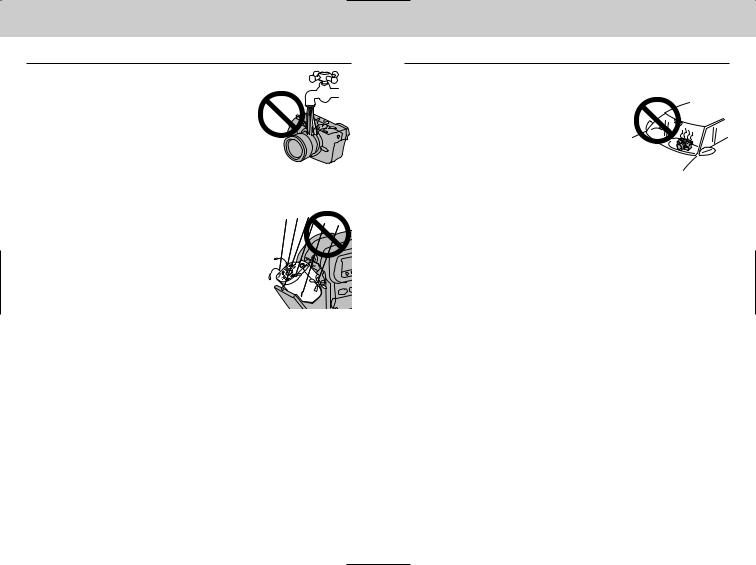
FOR PROPER AND SAFE USE
Splashproof
This camera is splashproof and can be used in light rain or snow.
• Do not place the camera under running water or immerse.
Please Note:
•When using the camera outdoors in
heavy rain, keep the camera protected from the rain.
•Do not leave the camera in the rain.
•The interior of the camera is not moisture resistant.
-Dry the camera before changing lenses or opening the film and battery chambers.
- Keep your hands dry when changing lenses or opening the film and battery chambers.
•Do not load film or replace batteries in
places where water, blowing sand, or dust can enter the camera.
•This camera is not sandproof, do not place the camera directly on the ground.
•Remove moisture from the camera.
•Do not expose the camera to salt water or liquids containing sugar.
•If the rubber seals appear cracked or damaged, contact the nearest Minolta Service Facility to have them replaced.
•Close the film and battery-chamber covers tightly. Clean the rubber seals before closing covers.
Operating Temperature and Conditions
•This camera is designed for use from -10 to 50 °C (14 to 122 °F).
•Never leave your camera where it may
be subjected to extreme temperatures such as the glove compartment of a car.
• At colder temperatures, the data panel response time will be slow. The display
will temporarily darken at higher temperatures, but will restore when the temperature normalizes.
•Never subject the camera to extreme humidity.
•To prevent condensation from forming, place the camera in a sealed plastic bag when bringing it from the cold exterior into a warm building. Allow it to come to room temperature before removing it from the bag.
•The low-battery symbol may appear even with fresh batteries depending on the storage conditions. To restore camera power, repeat turning the camera on and off.
•When photographing in cold weather, keep the camera and spare batteries inside your coat to keep them warm when you are not shooting. Cold batteries will regain some of their charge when they warm up.
6 |
7 |
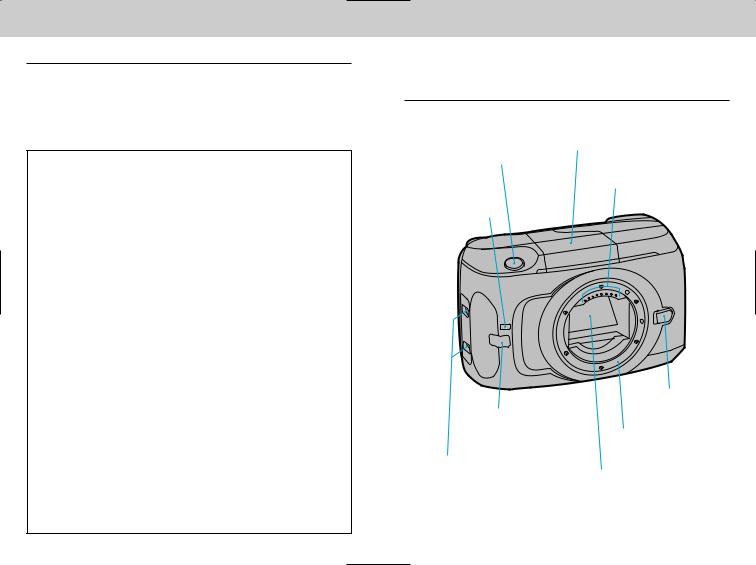
FOR PROPER AND SAFE USE
Film Cassette Warning
The film used in Advanced Photo System cameras stores some data magnetically. Do not place the cassette on or near anything that creates a magnetic field, such as a television or stereo speakers.
This device complies with Part 15 of the FCC Rules. Operation is subject to the following two conditions: (1) This device may not cause harmful interference, and (2) this device must accept any interference received, including interference that may cause undesired operation. Changes or modifications not approved by the party responsible for compliance could void the user’s authority to operate the equipment. This equipment has been tested and found to comply with the limits for a Class B digital device, pursuant to Part 15 of the FCC Rules. These limits are designed to provide reasonable protection against harmful interference in a residential installation. This equipment generates, uses and can radiate radio frequency energy and, if not installed and used in accordance with the instructions, may cause harmful interference to radio communications. However, there is no guarantee that interference will not occur in a particular installation.
If this equipment does cause harmful interference to radio or television reception, which can be determined by turning the equipment off and on, the user is encouraged to try to correct the interference by one or more of the following measures:
•Reorient or relocate the receiving antenna.
•Increase the separation between the equipment and the receiver.
•Connect the equipment to an outlet on a circuit different from that to which the receiver is connected.
•Consult the dealer or an experienced radio/TV technician for help.
This Class B digital apparatus meets all requirements of the Canadian Interference-Causing Equipment Regulations.
NAMES OF PARTS
For information on specific parts, refer to the page numbers shown in parenthesis.
Body
Built-in flash
Shutter-release button
Lens contacts*
Self-timer/Remote- receiver indicator
Lens release
Remote-control
receiver
Lens mount
Strap eyelets
Mirror*
* Do not touch
8 |
9 |
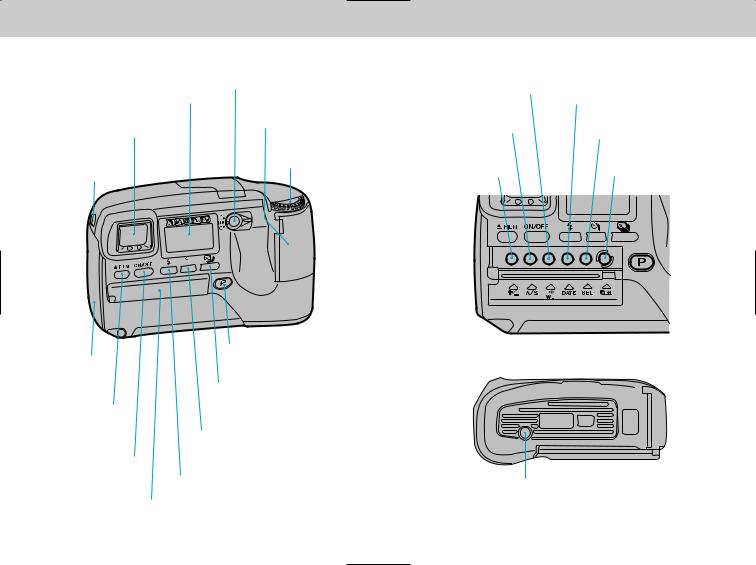
NAMES OF PARTS
|
Format-selector switch |
Data panel |
|
Viewfinder* |
Battery chamber |
|
|
Diopter- |
Control dial |
adjustment dial |
|
Film chamber |
Program-reset |
button (71) |
|
|
Subject-program-select |
Film-chamber |
button |
|
|
release |
Self-timer (57)/Drive-mode |
|
|
|
(58)/Remote-control button (59) |
Main switch |
|
|
Flash-mode button (33) |
Control-panel door
* Do not touch
Red-eye-reduction (34)/ Wireless-flash button (66)
Date button (52)
Exposure-mode button
Select button
Exposure-
compensation Manual-rewind button button (65)
Tripod socket
10 |
11 |
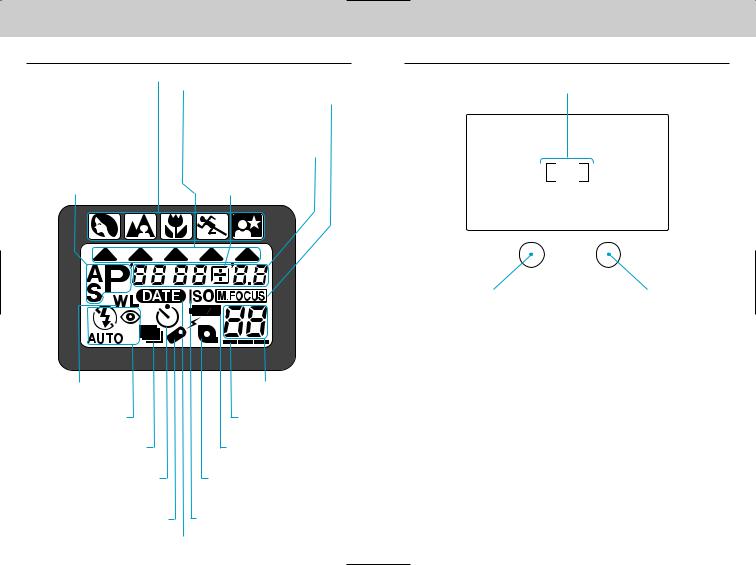
NAMES OF PARTS
Data Panel
Subject-program indicators
 Portrait Mode (38)
Portrait Mode (38)
 Landscape Mode (39)
Landscape Mode (39)
 Close-up Mode (40)
Close-up Mode (40)
 Sports Mode (41)
Sports Mode (41)
 Night Portrait Mode (42)
Night Portrait Mode (42)
Exposure-mode indicators (44)
Wireless-flash indicator (66)
Flash-mode indicators (32)
Continuous-drive indicator (58)
Self-timer indicator (57)
Remote-control indicator (59)
Subject-program pointer
Manual-focus indicator (56)
Shutter-speed/
Aperture/Film Speed/
Exposure-compensation/
Date/Time display
Exposure-compen- sation indicator (64)
Frame counter
Film-transport signals
Battery-condition indicator (19)
Cassette mark
Film-speed mark (26)
12 |
Date mark (52) |
|
Viewfinder
Focus frame
Flash lamp (orange) |
Focus lamp (green) |
||
Focus Lamp |
|
|
|
|
|
|
|
glows |
|
Focus is confirmed |
|
|
|
|
|
blinking |
|
Focus is not confirmed. Shutter cannot be released |
|
|
|
|
|
Flash Lamp |
|
|
|
|
|
|
|
glows |
|
Flash is charged |
|
|
|
|
|
blinks fast |
|
Flash is charging. Shutter cannot be released |
|
|
|
|
|
blinks slow |
|
Warning - light level is low, use flash or a tripod. |
|
|
|
|
|
13
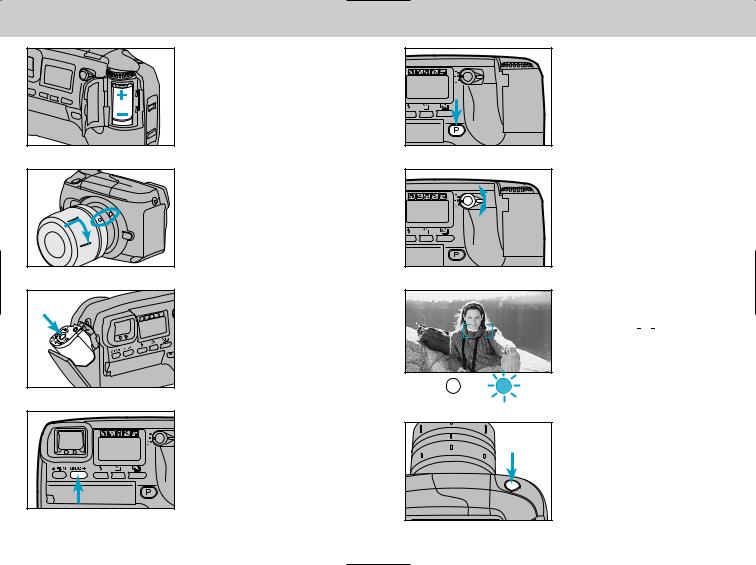
QUICK OPERATION
1. Insert battery
Open the battery-chamber door using the eyepiece cap. Insert the batteries into the chamber, then snap the battery-chamber door shut.
2. Attach lens
Align the red mounting dot on the lens with the one on the camera. Gently insert the lens into the mount and turn it clockwise until it clicks into the locked position.
3. Insert film
Press the film-chamber release. Insert the film cassette. Close the filmchamber door.
4. Turn on power
Press the main switch to turn the camera on.
14
5.Set Full Auto Operation
Press the program-reset button to set the camera to fullyautomatic operation.
6.Select print format
Turn the format-selector switch to the desired format before taking the picture.
7.Focus on the subject
Align the subject within the focus frame , then press the shutter-release button partway down.
The focus lamp will light when the subject is in focus. The flash will pop-up and fire when necessary.
8.Take the picture
Gently press the shutterrelease button all the way down to take the picture.
15
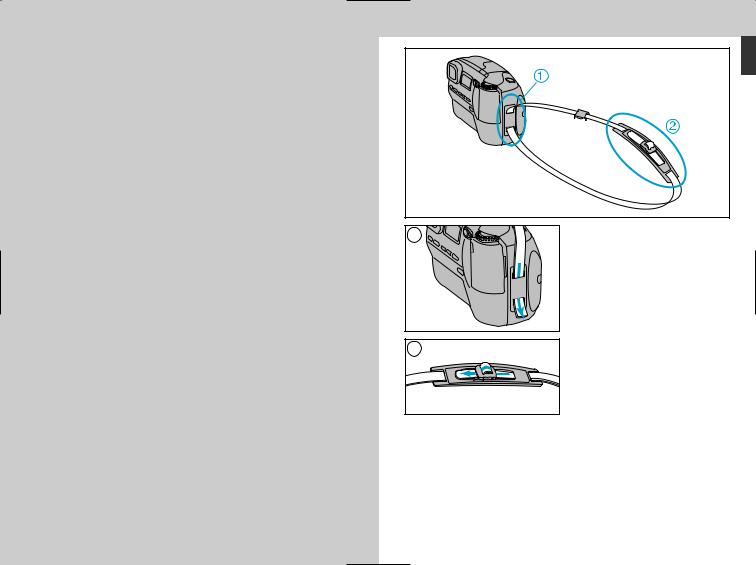
BASIC
OPERATION
This section provides the information necessary to operate your camera in most photographic situations.
This section covers:
•Battery Installation
•Attaching and Removing the Lens
•Diopter Adjustment and Camera Handling
•Loading and Rewinding the Film
•Fully Automatic Camera Operation
•Special Focus Situations
•Basic Flash Operation
Once you fully understand the instructions in this section, proceed to the Advanced Operation and Additional Features sections to obtain more enjoyment form your camera.
ATTACHING THE STRAP
1 |
Attach the camera strap as |
|
shown. |
2
16 |
17 |
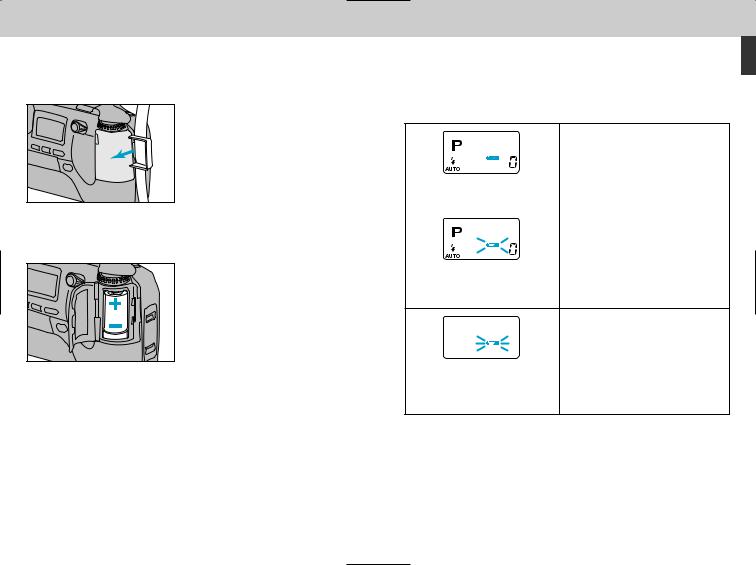
INSTALLING THE BATTERIES
Your camera uses two CR2 batteries to supply power for all camera operations.
1. Using the eyepiece cap, open the battery-chamber door.
• Turn the camera off before removing the old batteries.
• Remove dirt and moisture from the camera and batteries before opening the batterychamber door.
2. Insert the batteries as indicated by the + and – marks.
3. Snap the battery-chamber door shut.
•If the battery-chamber cover is not closed properly, moisture may enter the camera.
•If  and
and 




 blink in the data panel after the camera is turned on, reset the date and time. See page 52.
blink in the data panel after the camera is turned on, reset the date and time. See page 52.
CHECKING THE BATTERY POWER
Your camera is equipped with an automatic battery-power indicator. Each time the camera is turned on, the battery symbol will appear in the data panel to indicate the power status of the batteries.
|
|
|
|
|
|
|
Power is sufficient for all |
|
|
|
|
|
|
|
|
camera operations. |
|
Full-battery symbol |
|
|||||||
|
|
|
|
|
|
|
|
|
|
|
|
|
|
|
|
Power is extremely low, but all |
|
|
|
|
|
|
|
|
||
|
|
|
|
|
|
|
functions are operational. |
|
|
|
|
|
|
|
|
Battery will need to be |
|
|
|
|
|
|
|
|
replaced very soon. Flash |
|
Blinking low-battery symbol |
||||||||
recycling time may be slow. |
||||||||
|
|
|
|
|
|
|
||
Power is insufficient for
Blinking low-battery symbol camera operation. appears alone and
the shutter locks
•If no display appears, replace the battery or check that it is inserted correctly.
•Your camera shuts down if it is not operated for more than 30 minutes. Press the main switch to restore power.
18 |
19 |
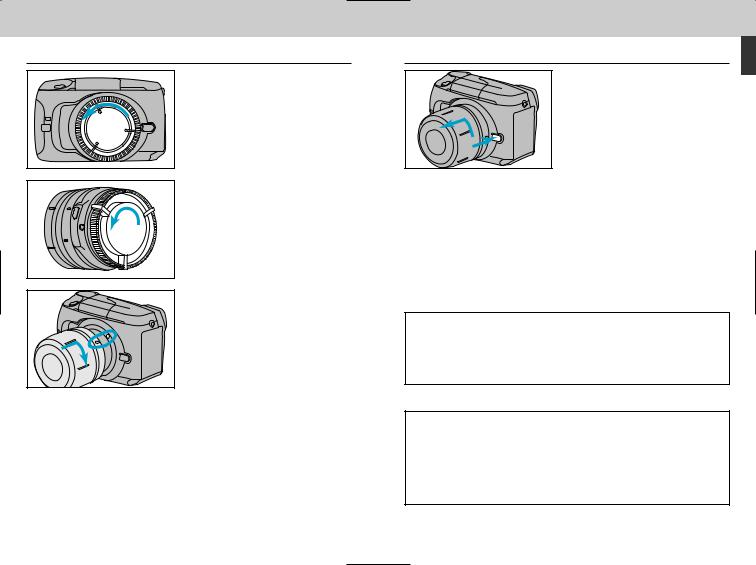
ATTACHING AND REMOVING THE LENS
Attaching the Lens |
Removing the Lens |
|
|
1. Remove the body cap. |
1. Press the lens release |
|
|
and turn the lens counter- |
|
|
clockwise until it stops. |
|
|
2. Gently remove the lens |
|
|
from the mount and |
|
|
replace the caps, or |
|
|
attach another lens. |
|
2. Remove the rear lens cap. |
|
5 |
6 |
|
0 |
|
|
8 |
|
|
|
AF/M |
|
3. Align the red mounting dots on the lens and camera body.
4. Gently insert the lens into the mount, then turn clockwise until it clicks into the locked position.
•Do not insert the lens at an angle.
•Do not press the lens release when attaching the lens.
20
Lens Hood Note
Attach a lens hood (page 74) to reduce flare and ensure maximum image quality. Flare reduces the contrast of the final image.
Caution
•Do not force the lens if it does not turn smoothly.
•Do not touch the inside of the camera, especially the lens contacts and mirror.
•Remove dust and dirt from the lens mount before attaching or removing a lens.
21
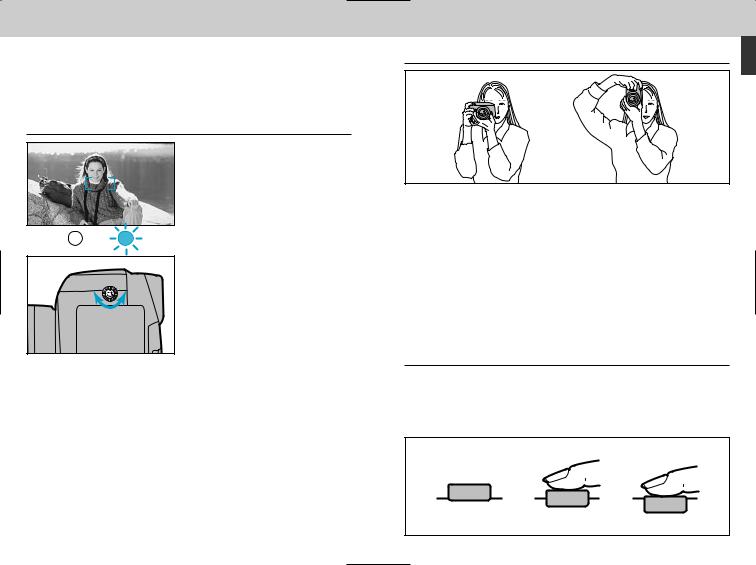
DIOPTER ADJUSTMENT
If you are near or far sighted, you can adjust the eyepiece for your eyesight. The diopter adjustment range is from -3.0 to +1.0 diopters.
Adjusting the Diopter:
1.Center your subject in the focus frame.
2.Press the shutter-release button partway down to focus on the subject.
3.Turn the diopter-
adjustment dial until the subject appears sharpest.
HANDLING THE CAMERA
Holding the Camera
Grip the camera firmly with your right hand, while supporting the lens with your left hand. Make sure your fingers don’t block the flash. Your fingers should fit securely around the grip. Keep your elbows at your side and your feet shoulderwidth apart to hold the camera steady. Always keep the camera strap around your neck or wrist in the event you accidentally drop the camera.
Pressing the shutter-release button
Press the shutter-release button partway down to activate the camera’s autofocus and auto-exposure systems. Gently press the shutter-release button all the way down to take the picture.
22 |
23 |
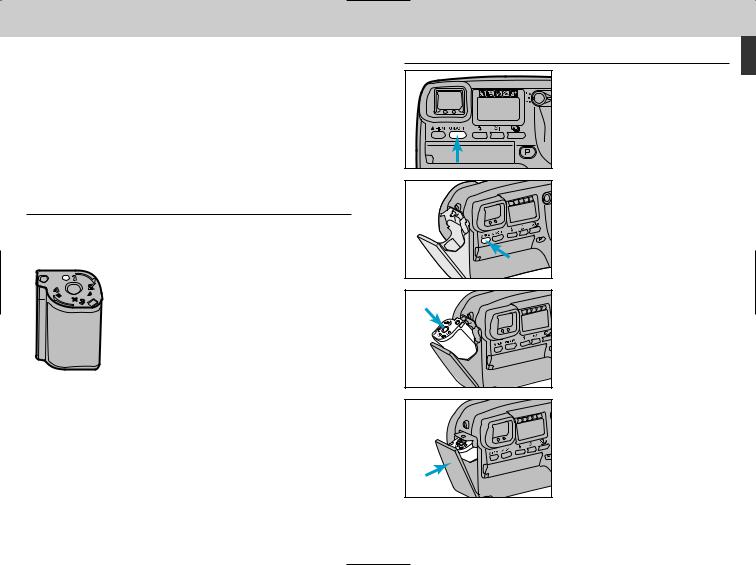
LOADING FILM
Use IX240 type film in this camera. |
Loading the Film |
|
• The automatic transport system will load the film, set the film |
1. Press the main switch to |
|
speed, and advance the film after each exposure. |
||
turn the camera on. |
||
• Once loaded, the film chamber cannot be opened until the film |
||
is rewound into the cassette (Film Chamber Lock). |
• Film can be loaded when the |
|
camera is on or off. |
||
• There is no need to worry about double exposure. The DEP |
||
|
||
(Double Exposure Prevention) feature prevents the camera |
|
|
from accepting exposed film. |
|
Visual Exposure Indicators
•The current VEI has a white indicator behind it.
•This camera can only load film with the ● VEI current.
VEI MEANING
● UNEXPOSED
PARTIALLY EXPOSED
EXPOSED
■PROCESSED
2.Press the film-chamber release on the back of the camera. The film-chamber door will open.
3.Insert a new film cassette into the film chamber with the VEI on top.
4. Push the film chamber in until it clicks shut.
24 |
25 |
